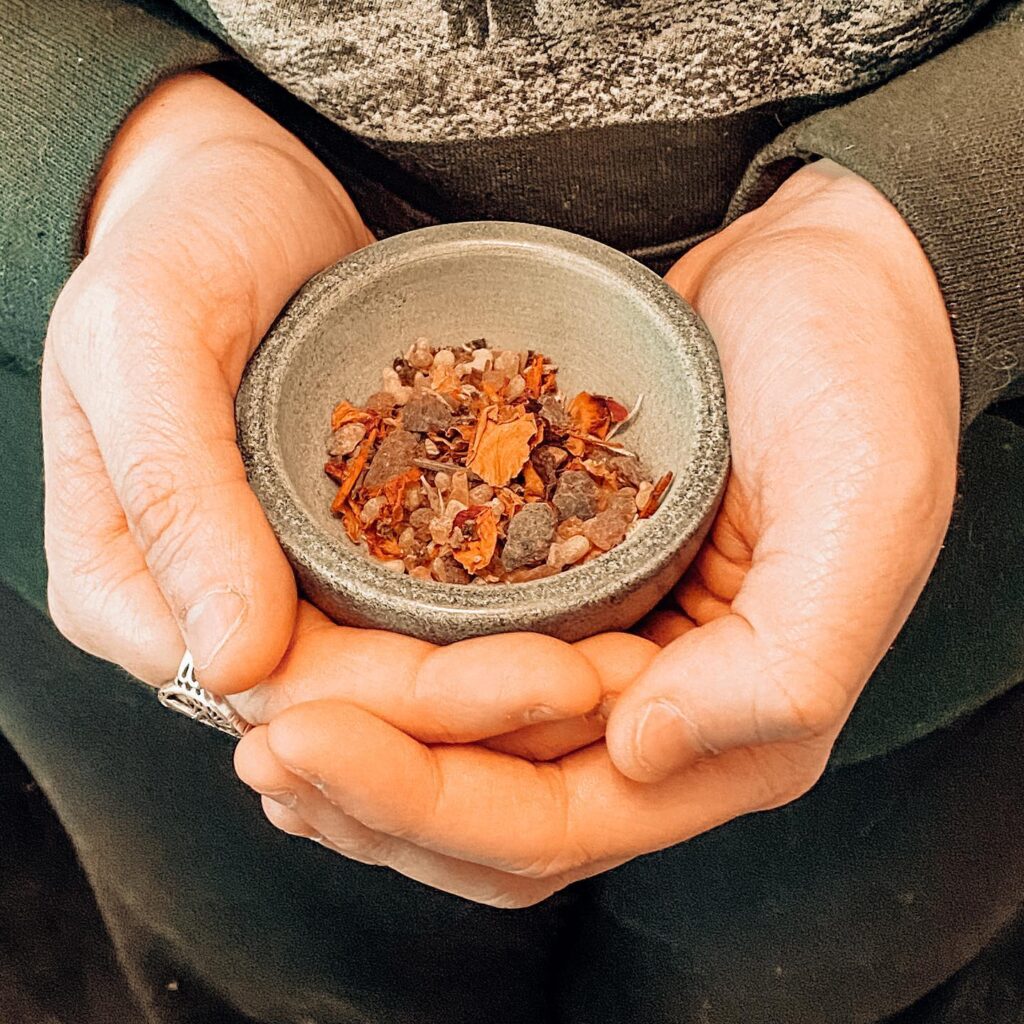Would you like me to read this to you? Click here:
One of my favourite roles, in the first coven in which I served, was making incense. For every ritual, whether esbat, sabbat, or something else, I would make loose incense linked with the magical intention for that gathering. It was something I enjoyed doing, and the incense itself always seemed to bring just what each coven-member needed. In and around rituals, I was always experimenting, trying to improve my recipes or work out why I’d instinctively discarded a particular herbal combination in favour of something completely different. I also tried and tested recipes from other sources — books, the internet, suggestions from other coven-members — and I also, at times, collaborated with fellow Witches in making an incense blend together. When we had teaching nights, the How to Make and Use Incense class was always one that brought much joy and laughter.
I am reminded of these times today, as I found an old journal entry containing a few of these recipes, and I’m also intrigued as to how things have changed over the years. For example, my go-to temple blend twenty-plus years ago was equal parts frankincense (Boswellia carteri), myrrh (Commiphora myrrha), mugwort (Artemisia vulgaris), and rose (Rose damascena). Currently, it is equal parts sandalwood (Santalum album) and patchouli (Pogostemon cablin) — but I did go through a phase where it was only frankincense.
Thinking about these green allies, and reflecting back on my memories of those early coven days, I remember the key intentions for my temple blend being cleansing, protecting, and healing. I also recall that, at the time, our High Priest preferred mugwort as his base in all incenses, whereas I preferred frankincense; whilst both have the qualities of protection and strength, he liked the amplification that mugwort brings, and I liked the added consecration elements from frankincense. Personal preference is important when choosing your incense blend; you want to be selecting a scent and intention that resonates with the magical work you’re about to undertake. For one thing, it will augment your ritual or spell-work; for another, it will help focus your mind and energy to the task at hand.
 Looking at my current favourite temple blend, sandalwood and patchouli, I can honestly say that I am fully embracing my love of woody and earthy scents when it comes to this one. I use it sparingly, because I am aware of the ecological impact that comes with harvesting sandalwood. That said, there is something special about the synergy of these scents, something that calls to me, that reminds me of the deep forest, the scent of earth after rain, the hint of autumn on the air. I find it deeply comforting, invigorating, and empowering. The herbs themselves are connected to protection and healing (sandalwood), and strength and grounding (patchouli), elements which are important to my current magical and spiritual practice.
Looking at my current favourite temple blend, sandalwood and patchouli, I can honestly say that I am fully embracing my love of woody and earthy scents when it comes to this one. I use it sparingly, because I am aware of the ecological impact that comes with harvesting sandalwood. That said, there is something special about the synergy of these scents, something that calls to me, that reminds me of the deep forest, the scent of earth after rain, the hint of autumn on the air. I find it deeply comforting, invigorating, and empowering. The herbs themselves are connected to protection and healing (sandalwood), and strength and grounding (patchouli), elements which are important to my current magical and spiritual practice.
This is not to say that I don’t use other incense, of course; I do — primarily incense sticks and loose blends. I still make my own, but I also enjoy using pre-made blends that I obtain from friends or occult shops. Sometimes buying pre-blended incense is a lot quicker or cheaper than obtaining the ingredients myself, particularly if it contains something I don’t usually have in my herbal apothecary. And if there’s a blend that works particularly well, or that I enjoy, or get good results with, then I will return to it time and again. There’s also the power of scent memory — one particular brand of incense sticks always transports me back in time to our favourite bed-and-breakfast in Glastonbury, England, where my husband and I spent many happy times, so we make sure we always have some at home. There’s also a specific blend that reminds me of working magic with my heart-sister, which is also very special, as is the hand-blended incense we made for our wedding day, and of which we still have some left.
Twenty-plus years ago, I prided myself on the size and variety of my herbal apothecary. I didn’t go out much, so I collected herbs — some wild-foraged, others bought from other parts of the UK and abroad. These days, I am much more ecologically minded, and so prefer to have a smaller apothecary which contains herbs from my locality or which are easily obtainable from the supermarket or the garden centre. I occasionally buy special ingredients — such as frankincense or sandalwood — in small quantities from trusted suppliers, who I know value earth-friendly harvesting practices. Others I grow myself, in my garden or on my windowsill.
Making incense is just one of the facets of my practice, and is one of the ways in which I feel closest to the Earth and the Witches who came before me. I always ask consent of the green allies involved, and I always work with them to awaken them and empower their qualities according to my need or intention. Fostering right relationships with your green allies — whether while spreading their leaves to the sun or when sitting dried in a jar — is good magical integrity and also helps to hone your intuition when it comes to working with the plant people. Taking the time to introduce yourself, explain your intention or the help you need, and then leaving some kind of offering in return, as an act of gratitude and acknowledgement of the plant’s sacrifice, is simply good manners and encourages energetic hygiene. For me, Witchcraft is a spirituality and practice born of the Earth; paying Her the right respects is essential in all acts of magic and ritual, even those that go on behind the scenes, such as growing and/or harvesting plants, and making incense.
Photograph is author’s own.
Soundtrack for this post: Various EPs and singles by Ruelle.


